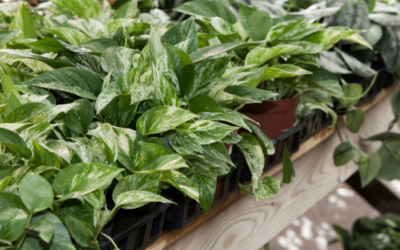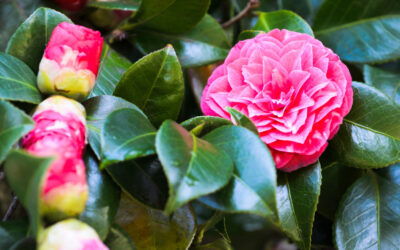Caring For Your Poinsettia
Poinsettias are a Christmas classic! Their modified leaves called bracts come in a variety of colors and variegations. The actual flowers of the plant are the tiny yellow centers surrounded by the colorful bracts. In their native Mexico, poinsettias are a perennial shrub that can grow up to 15’ tall! In our area, though, it’s a houseplant that can reach 2’ tall. With the proper care, yours will stay vibrant and healthy all through the holiday season.
Poinsettias do not like to be cold at all. They don’t even like their leaves to touch a cool window! When considering where to place yours, find a spot that stays between 65° and 75° that doesn’t get drafty. They also prefer higher humidity. You may need to mist yours daily, place it on a humidity tray of pebbles, or place it near a humidifier.
Its ideal spot would also receive lots of bright light. The brighter the light it receives, the more vibrants its colors will be. In shadier spots, its leaves may lose some of their color.
Water your poinsettia when the top inch of its soil is dry. They like their soil to stay moist, but not soaking wet. If you have it in a decorative pot cover, take it out so that the water can properly drain out. If you let it sit in standing water, the roots may rot.
Are Poinsettias Toxic?
Poinsettias are not poisonous. While they are not to be eaten as they can lead to an upset stomach, they are safe to have in your house. Poinsettias are, however, members of the Euphorbia family. The plants in this family all have a milky sap that can cause an itchy rash on those sensitive to it. Be careful when pruning yours, and make sure you wash your hands afterwards.
How To Get Your Poinsettia To Rebloom
It is difficult, but not impossible, to get your poinsettia to rebloom after the holidays. Because of the labor-intensive process, many people treat the plant as an annual and throw it out when it has finished blooming. After prunings and periods of controlled drought through the first half of the year, you’ll need to keep your poinsettia in complete darkness from 5:00 AM to 8:00 PM every day in October. In November, you should see new flower buds.
January – March
Continue to water your poinsettia when the soil is dry.
April
Gradually decrease your waterings and allow the soil to stay dry longer between waterings. Don’t let the stems start to shrivel, though. After a week or two, once it has acclimated to being dryer, move it to a spot that stays about 60°.
May
Cut the stems to about 4″ tall and repot in a slightly larger pot with a well-draining potting mix. Water when the soil is dry to the touch. When new growth begins to appear, begin to fertilize according to the fertilizer’s directions. We recommend Espoma Organic Plant-tone.
June
Move your poinsettia outside now that it’s hot!
July
Early in the month, pinch back the stems by about 1″ to encourage well-branching growth. Otherwise, the plant will get leggy.
August
Bring it back inside to the sunniest spot in your house. Prune the stems to leave 3 or 4 leaves on each one.
September
Continue watering and fertilizing according to the fertilizer’s directions.
October
Keep your poinsettia in complete darkness from 5:00 to 8:00. During the rest of the day, move it back to the sunny spot and continue to water and fertilize. Poinsettias are short-day plants, and this process will help them rebloom correctly.
November
Stop moving the poinsettia into the dark. You should start seeing flower buds.
December
Stop fertilizing mid-month. Continue to water. Enjoy your new blooms!
Make your yuletide season bright with colorful poinsettias! Have questions about their care? Our Martin’s Home & Garden team is ready to help.
This blog post was also published as an article in The Murfreesboro Post on December 2, 2019.


